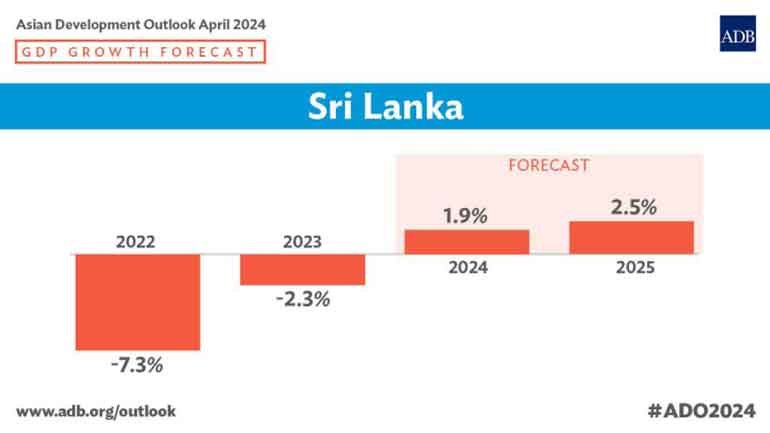Wednesday Feb 26, 2025
Wednesday Feb 26, 2025
Tuesday, 16 April 2024 01:01 - - {{hitsCtrl.values.hits}}

The Asian Development Bank’s (ADB) annual flagship economic publication, the Asian Development Outlook (ADO) April 2024, forecasts Sri Lanka’s economy to record moderate growth of 1.9% in 2024 and 2.5% in 2025 following 2 consecutive years of contractions.
Sri Lanka is showing signs of recovery, with green shoots emerging in the second half of 2023. Inflation has decelerated to single digits, foreign exchange reserves continue to be built up, and the exchange rate has appreciated. Tourist arrivals and remittance inflows continue to show a commendable recovery while supply conditions have improved.
ADB’s growth forecast hinges on the continuation of reforms and better consumer and business sentiment. Timely completion of external debt restructuring will also support Sri Lanka’s debt sustainability efforts.
“Sri Lanka has made commendable progress in implementing difficult policy reforms and stabilising the economy in 2023,” said ADB Deputy Country Director for Sri Lanka Utsav Kumar. “We are pleased to see the results of these reforms, with signs of recovery emerging. It is critical that Sri Lanka addresses the impact on the poor and vulnerable and also continues to implement reforms to address the underlying causes of the crisis and lay the foundation for fostering sustainable recovery, building resilience, and reviving growth.”
Addressing poverty vulnerabilities amid economic recovery is a major challenge faced by the country. Poverty gains eroded as a result of the COVID-19 pandemic and the subsequent economic crisis. As the economy stabilises, the country must ensure that the most affected and vulnerable groups of people are supported, and high poverty incidence and income inequality are addressed. This calls for appropriate institutional and structural frameworks for an inclusive social protection system with improved targeting. Creating jobs and fostering sustainable livelihoods would go a long way toward alleviating poverty.
ADB said it is committed to achieving a prosperous, inclusive, resilient, and sustainable Asia and the Pacific, while sustaining its efforts to eradicate extreme poverty. Established in 1966, it is owned by 68 members—49 from the region.
Discover Kapruka, the leading online shopping platform in Sri Lanka, where you can conveniently send Gifts and Flowers to your loved ones for any event including Valentine ’s Day. Explore a wide range of popular Shopping Categories on Kapruka, including Toys, Groceries, Electronics, Birthday Cakes, Fruits, Chocolates, Flower Bouquets, Clothing, Watches, Lingerie, Gift Sets and Jewellery. Also if you’re interested in selling with Kapruka, Partner Central by Kapruka is the best solution to start with. Moreover, through Kapruka Global Shop, you can also enjoy the convenience of purchasing products from renowned platforms like Amazon and eBay and have them delivered to Sri Lanka.
Discover Kapruka, the leading online shopping platform in Sri Lanka, where you can conveniently send Gifts and Flowers to your loved ones for any event including Valentine ’s Day. Explore a wide range of popular Shopping Categories on Kapruka, including Toys, Groceries, Electronics, Birthday Cakes, Fruits, Chocolates, Flower Bouquets, Clothing, Watches, Lingerie, Gift Sets and Jewellery. Also if you’re interested in selling with Kapruka, Partner Central by Kapruka is the best solution to start with. Moreover, through Kapruka Global Shop, you can also enjoy the convenience of purchasing products from renowned platforms like Amazon and eBay and have them delivered to Sri Lanka.